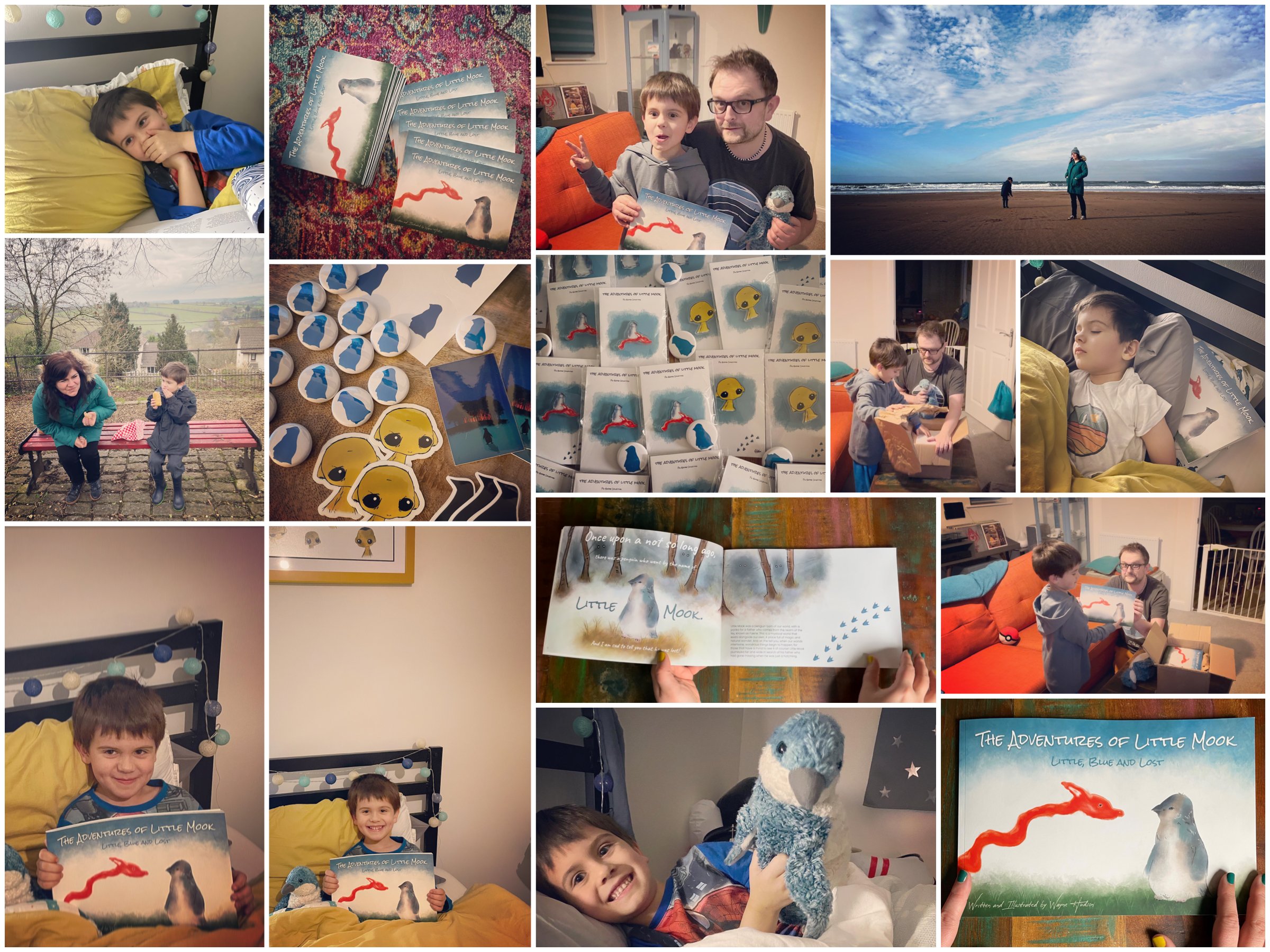Little Mook - Just the start.
In early January, my finished book The Adventures of Little Mook: Little, Blue and Lost arrived by the box load from TJBooks, my wonderful printers in Padstow. Opening the boxes with my wife Ana and our son Jude was a moment I’ll never forget. Ana told me how proud and excited she was, knowing how much this passion project meant to me. Jude, meanwhile, was bouncing around, desperate to see what was inside. When he realised it was his book, he squealed with joy—it was a sight I’ll treasure forever.
I’ve wanted to write a children’s book since primary school, when a substitute teacher had us all make our own versions of a Mr. Men story. I still remember the spark of joy that came from creating something like the books I loved at the time. Over the years I kept scribbling ideas, circling around different stories and characters. “The Mook” had always been a bigger, multiverse-sized idea (as this website shows), but “Little Mook” felt perfect for a little blue penguin. The name stuck, though I tried out others along the way. When my son was born, I knew: I would make him a book, and it would feature this penguin. The hard part was knowing where to start.
Part of the inspiration came from a book my parents gave me as a child, published by P.G. Tips. It featured me and two of my friends, Callum and Ricky, woven into a story about their famous advertising chimps. I loved seeing my own name in print, part of an adventure. I knew then that my own story would also weave in real people and places—my son included (he’ll make his proper appearance in book two). I also thought of Sofie Dahl, who inspired The BFG, and how magical it must have been to grow up with Roald Dahl as a grandfather.
At first, I considered illustrating the book myself. I’d always loved drawing as a child, but I hadn’t picked up a pencil seriously since I was 15. Then fate intervened: I saw a stunning watercolour of a French Bulldog on a Facebook group, painted by a young artist named Ellise. I reached out, and she loved the idea of a book for my son. She brought Little Mook—and even a young version of Jude—to life beautifully. But life got busy: fatherhood and sleepless nights for me, university for Ellise. The project stalled. I kept telling Jude Little Mook’s adventures, but the page stayed blank.
Years later, I asked Ellise if we could restart, but she couldn’t commit. She generously gave me her blessing to continue with her designs if I found another illustrator. For a while I didn’t know what to do. Could I find someone to bring the penguin to life again? Or would I need to try myself? In the end, I threw caution to the wind and picked up my pencils after more than 20 years. To my surprise, the drawings began to flow. My style was different from Ellise’s, but it carried the feeling I wanted. More importantly, I had complete creative control, and it was up to me to make it happen or not.
Reimagining Little Mook was daunting. I needed to adapt what Ellise and I had created so I could draw him consistently while keeping his spirit alive. Rediscovering my artistic voice was a challenge, but also deeply rewarding. As a child, I’d been discouraged from pursuing art seriously, so I’d turned to photography instead. Now, I found myself channelling years of creative energy into illustration. Inspired by artists like Bill Watterson (Calvin and Hobbes), I shaped Little Mook’s new look and began expanding his world.
Living in Launceston, Cornwall, with Jude now approaching his fifth birthday, the stories became richer. We invented gromlings together, searched the countryside for their hiding places, and dreamed up Little Mook’s adventures as we walked. Jude often added his own ideas—making the project even more special.
I picked up my pencils again in March 2021, aiming to create a few prints for Jude’s birthday. Ten months later, I had not only the artwork but also a fully designed book, thanks to a close friend who taught me the basics of InDesign. The story flowed better than I ever imagined. What began as a gift for my son now had the potential to reach other children, too.
In the end, I self-published a limited run of 200 copies. To see the book on shelves in local shops has been surreal and thrilling. When I heard one had sold at The Byre, and saw a post from a grandmother who’d bought it for her grandson, I was overjoyed.
It hasn’t been easy. Dyslexia and an eye condition called keratoconus both make the process a challenge. Add my tendency to obsess over details, and it can feel like a battle. I’m endlessly checking and re-checking, worried I’ve missed something. Thankfully, friends helped proofread, though I’m sure I’ll still spot the odd error that will haunt me. But a friend, Dave, gave me wise advice: “Finished is better than perfect.” That doesn’t mean settling for shoddy work—it means allowing your art into the world, flaws and all, instead of hiding it away forever.
And now, here we are. A limited run, a few boxes still in my office, and the beginnings of book two already underway. Little Mook is no longer just an idea in my head—he’s alive, in print, part of our family life, and ready to be shared. Maybe there’ll be a second run, maybe not. Either way, this little blue penguin is out in the world at last.

